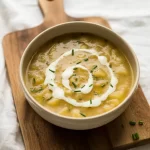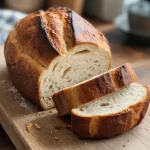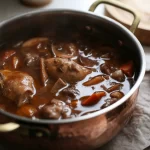OMG, I just whipped up the most delicious homemade pesto, and I’m absolutely living for its vibrant green goodness! The fresh basil aroma instantly transports me to an Italian summer, and trust me, friends, you’re gonna want this on everything from pasta to morning toast—it’s a total game-changer! 🌿🥖✨

I love creating simple yet flavor-packed dishes, and my Simple Basil Pesto is a perfect example. With packed fresh basil leaves, freshly grated Parmesan-Reggiano cheese, and a splash of extra virgin olive oil, this pesto is not only delicious but also rich in antioxidants and healthy fats.
Simple Basil Pesto Recipe Ingredients

- Fresh Basil Leaves: Packed with vitamins A and K, rich in antioxidants.
- Parmesan-Reggiano Cheese: Adds umami flavor, good source of calcium and protein.
- Extra Virgin Olive Oil: Contains healthy fats, known for heart benefits.
- Pine Nuts: Rich in healthy fats, protein, and magnesium.
- Garlic Cloves: Enhances flavor, may support immune health.
Simple Basil Pesto Recipe Ingredient Quantities
- 2 cups fresh basil leaves, packed
- 1/2 cup freshly grated Parmesan-Reggiano cheese
- 1/2 cup extra virgin olive oil
- 1/3 cup pine nuts
- 2 medium-sized garlic cloves, minced
- 1/4 teaspoon salt, or to taste
- 1/4 teaspoon freshly ground black pepper, or to taste
How to Make this Simple Basil Pesto Recipe
1. Begin by washing the fresh basil leaves thoroughly under cold water to remove any dirt or impurities, then pat them dry with a clean kitchen towel or paper towels.
2. In a food processor, combine the basil leaves and pine nuts. Pulse a few times until the ingredients are coarsely chopped.
3. Add the minced garlic cloves to the mixture in the food processor. Pulse a few more times until everything is well combined.
4. Slowly drizzle in the extra virgin olive oil while the food processor is running. This helps to emulsify the mixture, creating a smooth consistency.
5. Stop the processor and use a spatula to scrape down the sides of the bowl, ensuring all ingredients are evenly mixed.
6. Add the freshly grated Parmesan-Reggiano cheese to the mixture in the food processor.
7. Season the pesto with 1/4 teaspoon of salt and 1/4 teaspoon of freshly ground black pepper, or adjust to taste.
8. Pulse the entire mixture a few more times until the pesto reaches your desired texture. Some prefer it chunkier, while others like it smoother.
9. Taste the pesto and adjust seasoning if necessary. You can add more salt, pepper, or olive oil to achieve your preferred flavor and consistency.
10. Transfer the pesto into a jar or airtight container. To store, cover the top with a thin layer of olive oil to prevent oxidation and keep it fresh. Refrigerate until ready to use. Enjoy as a spread, dip, or pasta sauce!
Simple Basil Pesto Recipe Equipment Needed
1. Food processor
2. Measuring cups
3. Measuring spoons
4. Spatula
5. Kitchen towel or paper towels
6. Knife
7. Cutting board
8. Grater
9. Jar or airtight container
FAQ
- Q: Can I make this pesto without nuts?
A: Yes, you can substitute pine nuts with sunflower seeds or omit them altogether if you have allergies. - Q: How can I store leftover pesto?
A: Store pesto in an airtight container in the refrigerator for up to one week. To extend freshness, drizzle a thin layer of olive oil on top before sealing. - Q: Can I freeze basil pesto?
A: Yes, pesto freezes well. Portion it into ice cube trays, freeze, then transfer to a freezer-safe bag for up to 3 months. - Q: What can I use instead of Parmesan-Reggiano cheese?
A: You can use Pecorino Romano, Grana Padano, or nutritional yeast for a dairy-free version. - Q: Is there a substitute for extra virgin olive oil?
A: While olive oil is traditional, you can use a neutral oil like grapeseed or avocado oil, although the flavor will be different. - Q: Can I add lemon juice to the pesto?
A: Yes, adding a tablespoon of lemon juice can brighten the flavor of the pesto. - Q: How do I keep the basil pesto from turning brown?
A: Blanch the basil leaves briefly in boiling water before blending, and make sure to store the pesto with a layer of olive oil on top to minimize oxidation.
Simple Basil Pesto Recipe Substitutions and Variations
- For the basil leaves, you can substitute with spinach or arugula.
- Instead of Parmesan-Reggiano, use Pecorino Romano or nutritional yeast for a dairy-free option.
- Substitute pine nuts with walnuts or almonds.
- If you don’t have extra virgin olive oil, try using avocado oil.
- For minced garlic, you can use garlic powder (1/4 teaspoon per clove) or roasted garlic for a milder flavor.
Pro Tips
1. Toast the Pine Nuts Before adding them to the food processor, lightly toast the pine nuts in a dry skillet over medium heat until golden and fragrant. This enhances their nutty flavor.
2. Chill the Food Processor Blade For a brighter green pesto, chill your food processor blade and bowl in the refrigerator before use. This helps prevent the basil from oxidizing and turning dark.
3. Experiment with Flavors For a unique twist, consider substituting part of the basil with other herbs like parsley or cilantro, or add a splash of lemon juice for a fresh, tangy kick.
4. Add Cheese Gradually If you prefer a creamier texture, try adding the Parmesan cheese gradually and processing it longer to achieve a smoother pesto.
5. Freeze in Portions If you have leftover pesto or want to make it in advance, freeze it in an ice cube tray. Once frozen, transfer the cubes to a freezer bag for easy portioning. Before using, you can thaw as many cubes as needed.

Simple Basil Pesto Recipe
My favorite Simple Basil Pesto Recipe
Equipment Needed:
1. Food processor
2. Measuring cups
3. Measuring spoons
4. Spatula
5. Kitchen towel or paper towels
6. Knife
7. Cutting board
8. Grater
9. Jar or airtight container
Ingredients:
- 2 cups fresh basil leaves, packed
- 1/2 cup freshly grated Parmesan-Reggiano cheese
- 1/2 cup extra virgin olive oil
- 1/3 cup pine nuts
- 2 medium-sized garlic cloves, minced
- 1/4 teaspoon salt, or to taste
- 1/4 teaspoon freshly ground black pepper, or to taste
Instructions:
1. Begin by washing the fresh basil leaves thoroughly under cold water to remove any dirt or impurities, then pat them dry with a clean kitchen towel or paper towels.
2. In a food processor, combine the basil leaves and pine nuts. Pulse a few times until the ingredients are coarsely chopped.
3. Add the minced garlic cloves to the mixture in the food processor. Pulse a few more times until everything is well combined.
4. Slowly drizzle in the extra virgin olive oil while the food processor is running. This helps to emulsify the mixture, creating a smooth consistency.
5. Stop the processor and use a spatula to scrape down the sides of the bowl, ensuring all ingredients are evenly mixed.
6. Add the freshly grated Parmesan-Reggiano cheese to the mixture in the food processor.
7. Season the pesto with 1/4 teaspoon of salt and 1/4 teaspoon of freshly ground black pepper, or adjust to taste.
8. Pulse the entire mixture a few more times until the pesto reaches your desired texture. Some prefer it chunkier, while others like it smoother.
9. Taste the pesto and adjust seasoning if necessary. You can add more salt, pepper, or olive oil to achieve your preferred flavor and consistency.
10. Transfer the pesto into a jar or airtight container. To store, cover the top with a thin layer of olive oil to prevent oxidation and keep it fresh. Refrigerate until ready to use. Enjoy as a spread, dip, or pasta sauce!
















